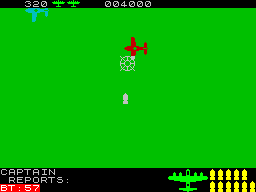Digital Integration was a minor British developer best known for flight sims like Hind and Apache, and are credited with distribution on several UK budget re-releases. They didn't produce many whales of their own, and their earliest bona fide whale is 1989's F-16 Combat Pilot, but 1985 seemed a good year to introduce the company with Commodore 64 racer Speed King and their backlog up to it.
Their first game, Night Gunner, was originally developed for the ZX81, and like most ZX81 games is a barely playable piece of crap.
It's Star Fire, just with a WWII bomber theme. That makes the third Star Fire clone I've played that was made by a British bedroom programmer in 1982, and this is the worst one yet. To hit your targets you have to tediously nudge them into the center of your screen with painfully unresponsive cursor keys, awkwardly mapped to the 5-6-7-8 keyboard cluster (as it is with a real ZX81 keyboard), and whenever you push them it's not always clear whether the input was accepted or not.
I'd just move onto the next one, except that the ZX Spectrum version of the same game appears to be substantially different.
 |
| Alas, it's still not a side-scrolling shmup where you play as a flying wizard. |
You will definitely want to emulate a joystick - the keyboard layout makes no sense even by ZX Spectrum standards.
It's still much like Star Fire, though this time the crosshairs move instead of your point of view, and it's all the better for it, even with more responsive controls than in the ZX81 original.
You still need to hit your targets dead-center, and now you have to lead them as well, but at least you have rapid-fire. Ammo is finite but I never ran out of it. Perhaps it becomes an issue on later missions.
On the higher difficulty levels, your plane takes damage FAST, and this affects the plane's speed and handling. It's usually not even worth trying to shoot down the defenseless blimps, because you really don't want to let the fighters stay alive for a moment longer than necessary.
Once the plane reaches its destination, you switch to bombing mode.
 |
| Somehow the bombing is at day. |
Here, there's no reason not to slow down to minimum velocity. You can't hit all of the targets, but the more accurately you bomb, the more points you score. The time limit is irrelevant; you'll certainly drop your bombs before time runs out, at either which point you turn around, return to the tailgunner seat, and try to survive the trip home.
Subsequent missions follow the same format - gunning, bombing, gunning - but get more difficult. Enemies get faster and more numerous, bombing targets become mobile ones like tanks and trucks, and sometimes it is a dive-bombing mission, which is far more difficult.
Once a targets appears past the horizon, you only have a few seconds before it passes under your firing line. If you aren't already diving when you see it, it's too late - and your altitude drops fast!
The tape liner claims 30 missions, but I couldn't get anywhere near close to that.
GAB rating: Below average. The ZX Spectrum is luxurious compared to the ZX81, but destitute compared to the Atari 800. With functional controls and visuals and some gameplay variety, this is one of the better action games I've played on an ultra-budget micro before, but that isn't saying much; only three such games have managed average or better (3D Starstrike, Gridrunner, Jetpac).
















When is the next article?
ReplyDeleteThe Amstrad CPC version, which I played endlessly as a child, is excellent, and available here:
ReplyDeletehttps://www.cpc-power.com/index.php?page=detail&num=1515